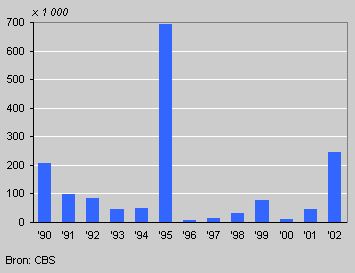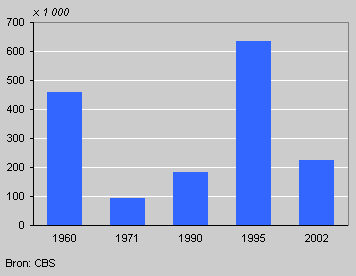Most strike days in construction in 2002

Twenty-nine thousand workers in the Netherlands went onn strike in 2002. This resulted in 245 thousand days of work lost. More than 91 percent of this was the consequence of the builders’ strike. Only in 1995 and 1960 were more days lost because of strikes in this sector. Compared with sickness absence, the loss of working days caused by industrial action was small.
Number of strike days fluctuates strongly
Every year workers strike to exact certain demands from their employers. The post war record for the number of days lost through strikes was set in 1995, when 692 thousand working days were lost. In the subsequent period the number of strike days varied between 76 thousand in 1999 and 7 thousand in 1996. At 245 thousand strike days, the number of days lost in 2002 was relatively high.
Working days lost because of strikes

Days lost by sector
Most of the working days were lost because of the strike in the construction industry. This was caused by the deadlock in the negotiations for the collective wage agreements. In 2002 224 thousand working days were lost in this sector, just over 91 percent of the total days lost. Workers in the manufacturing industry and in transport and communication also took industrial action. In these sectors 3 thousand and 17 thousand working days respectively were lost.
Strikes in construction
The builders’ strike in 2002 was not the largest in this sector. In 1995 634 thousand working days were lost because builders went on strike. In 1960, too, there was widespread industrial action in this sector, resulting in 459 strike days. The builders’ strike in 2002 was the third largest since 1960, with 224 thousand strike days.
Strike days in construction

More working days lost because of sickness
The number of strike days is small compared with the number of working days lost because of sickness. In 2002 the sickness absence rate in the construction industry was 5.2 percent. The builders’ strike of 2002 resulted in a loss of 0.2 percent of the labour volume in this sector.
Jo van Cruchten and Rob Kuijpers